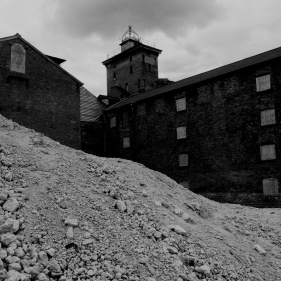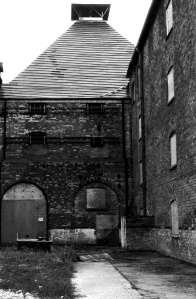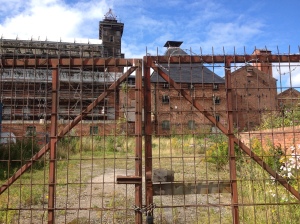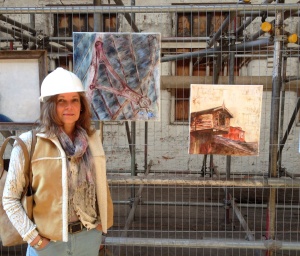The Building that Changed the Face of the World!
by rebeccaMpells
“It is one of those rare structures that changed the world of construction and design. With it’s revolutionary iron frame it was the predecessor of the modern sky-scrapper.” These are the words of Sir Neil Cossons, former chairman of English Heritage about the Flaxmill in Shrewsbury, UK.
Described as the ‘grandfather of skyscrappers’ although it is no taller than a modern five storey building, the Flaxmill was designed as a ‘manufactory’ for the processing of flax into fine linen, by architect and amateur engineer Charles Bage in 1796. Influenced by his friend Thomas Telford and Abraham Darby’s now infamous Ironbridge just 15  miles down the road, it was the first time a building had been constructed with an internal iron frame. The fireproof combination of cast iron columns and cast iron beams was a system which later developed into the modern steel frame making modern skyscrappers possible. The success of the Shrewsbury Flaxmill quickly spread to a series of other iron frame mills in Britain reducing fire risk but fuelling the industrial revolution.
miles down the road, it was the first time a building had been constructed with an internal iron frame. The fireproof combination of cast iron columns and cast iron beams was a system which later developed into the modern steel frame making modern skyscrappers possible. The success of the Shrewsbury Flaxmill quickly spread to a series of other iron frame mills in Britain reducing fire risk but fuelling the industrial revolution.
 That is quite a CV for one a building! But there is so much more to The Flaxmill’s heritage than just facts. It’s impact was not only on the development of architecture but on the progress of industry, economy and wealth, population, housing and lives. It has touched four centuries, crossing the threshold of three. At the time of construction of the main mill building America had not long since won it’s independence, the dust was still settling after the Storming of the Bastille in France and Shrewsbury’s most famous son Charles Darwin had yet to be born.
That is quite a CV for one a building! But there is so much more to The Flaxmill’s heritage than just facts. It’s impact was not only on the development of architecture but on the progress of industry, economy and wealth, population, housing and lives. It has touched four centuries, crossing the threshold of three. At the time of construction of the main mill building America had not long since won it’s independence, the dust was still settling after the Storming of the Bastille in France and Shrewsbury’s most famous son Charles Darwin had yet to be born.
This sense of encompassing history is palpable. The collection of buildings radiate an imposing heaviness, weary of having witnessed too much but it’s iron skeleton provides not just a frame but an iron will to keep standing when gravity and time would have it otherwise. Woven into it’s walls are the stories of all who have lived and worked within them – the blood, the sweat, the tears, the deaths. Two hundred and twenty years spinning, twisting, weaving their threads and stories from the 18th to the 21st century. The iron frame soars with dignity above your head, the warp and the weft of the architects pen waiting patiently for the next plan to be drawn.
 I have passed by this building hundreds of times but it has only been recently when I had the opportunity to exhibit a couple of my paintings during the Flaxmill Heritage Open days that I have taken any real notice of it. Researching it’s history in preparation for my work it is only now that I have come, with some guilt, to appreciate the influence it has had in the development of the modern world. Imagine the 21st century without skyscrappers – where would all the businesses go, where would all the people live? London, New York, Tokyo would not be the places they are today. Things could have taken a very different path. But they didn’t – thanks to one Charles Bage and his iron framed Flaxmill.
I have passed by this building hundreds of times but it has only been recently when I had the opportunity to exhibit a couple of my paintings during the Flaxmill Heritage Open days that I have taken any real notice of it. Researching it’s history in preparation for my work it is only now that I have come, with some guilt, to appreciate the influence it has had in the development of the modern world. Imagine the 21st century without skyscrappers – where would all the businesses go, where would all the people live? London, New York, Tokyo would not be the places they are today. Things could have taken a very different path. But they didn’t – thanks to one Charles Bage and his iron framed Flaxmill.
It was to be a further twelve years before another Shrewsbury man named Charles would also change the world. Charles Darwin. But that’s a whole other story!
For further information about Shrewsbury Flaxmill visit Friends of the Flaxmill Maltings
For my artwork visit Rebecca Pells Artist


Fascinating reading, Rebecca. I had not heard of Flaxmill before, so thanks for the insight. I like your artwork! Great photos too.
LikeLiked by 1 person
Thank you Chris. It is certainly a fascinating group of buildings and you can feel the history oozing from them!
LikeLiked by 1 person
Beautifully photographed and written in such a wonderfully poetic style of prose.
LikeLiked by 1 person
Thanks Michael. I’m glad you enjoyed the post.
LikeLiked by 1 person
Wonderful, thanks for sharing this.
LikeLiked by 1 person
Glad you enjoyed!
LikeLiked by 1 person
How interesting! I never thought to question the roots of the now very ubiquitous and essential I-beam – but now I know. Thank you! 🙂
LikeLiked by 1 person
Thanks Eliza. We don’t often think about how our everyday surroundings came to be but the stories can be fascinating.
LikeLike
That’s quite a history. And as you say, an impressive CV.
LikeLiked by 1 person
Thanks Bruce. My own CV pales into insignificance by comparison!
LikeLike
I followed the link you provided, and saw that the atmospheric Flaxmill only closed in 1987! Do you know if any films have been filmed on the property? Certainly, it’s a signature backdrop to the art show. Did all the artists portrait the Flaxmill? I viewed your work at your art site, by the way – beautiful!
LikeLike
Hi JoAnn. The Flaxmill is currently under major conservation work funded by English Heritage and Lottery UK. There are a number of buildings a couple which community events take place in already – like the art exhibition but hard hats must be worn. The Flaxmill regularly appears in documentary/history programmes on TV but I’m not aware of it being used in a film – though I’m sure that could happen in the future once it’s a safe environment!
Thank you for checking out my own site and your lovely comment. 🙂
LikeLiked by 1 person
Thanks for the update, Rebecca – have a great week!
LikeLiked by 1 person
Fascinating reading! And I like your paintings!
LikeLiked by 1 person
Thank you!
LikeLike